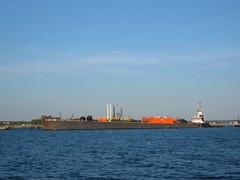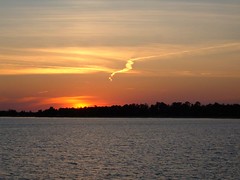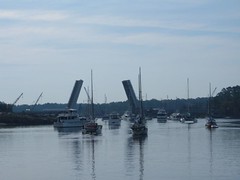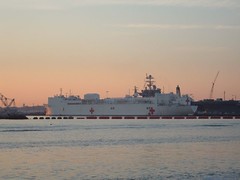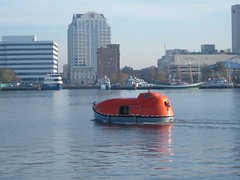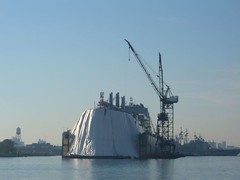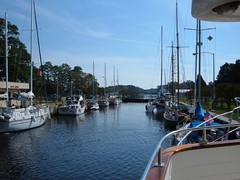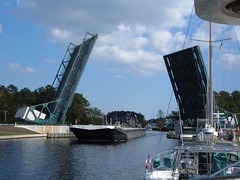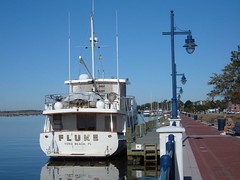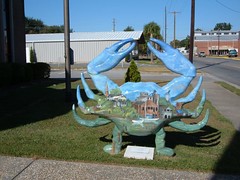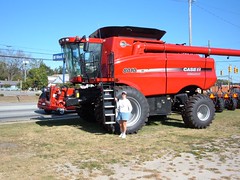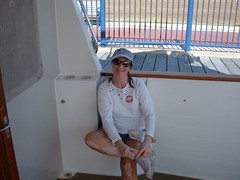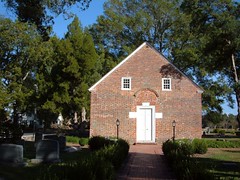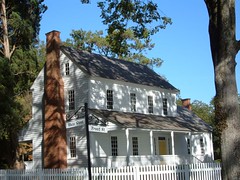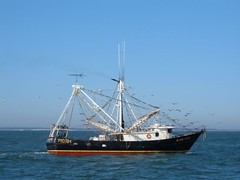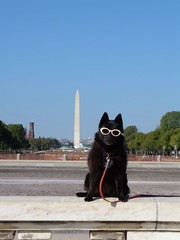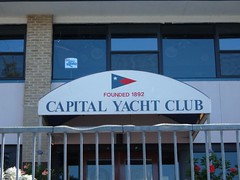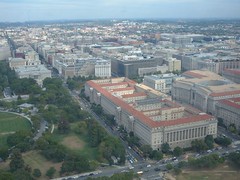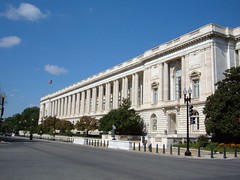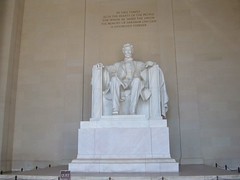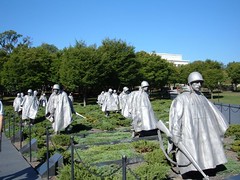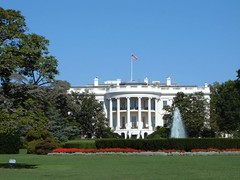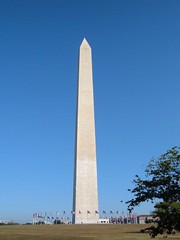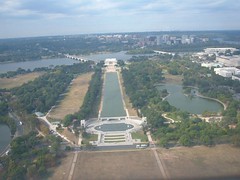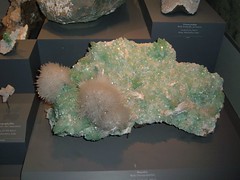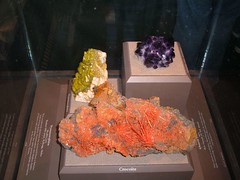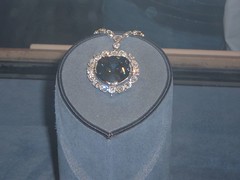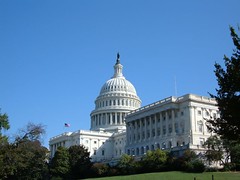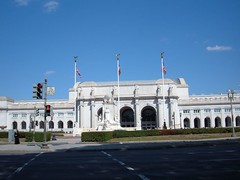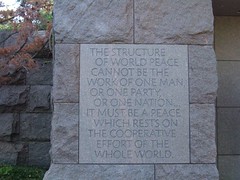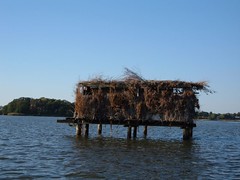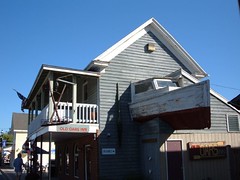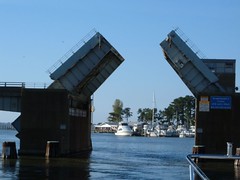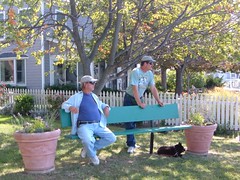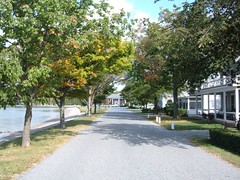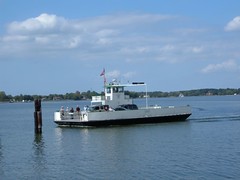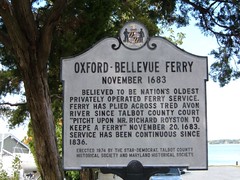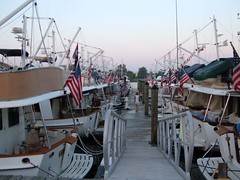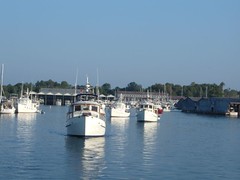Monday, December 24, 2007
Sunday, November 25, 2007
THE REST OF THE STORY
October 14 – November 5, 2007
The following text describes the last of our adventures for the 2007 trip north. I actually worked on some of this section before arriving back in Vero, but had to finish it off and do the posting after we arrived at the home dock. The delay has been due to trying to get caught up with the house needs; our house is still for sale and the winter real estate season has begun, so we had to do all the things necessary to ready it for potential buyers. In this tough selling market we need to do whatever it takes to even get people to look at the house. Getting and consummating a contract will require a category 3 miracle.
We left the Washington Channel anchorage at first light on October 14 so that we could make good time heading down the Potomac. I phoned the Harbor Patrol to tell them that we had pulled up the hook. After an uneventful day on the big river, and as the sun was getting ready to set, we dropped the hook at Piney Point, MD right around the corner from a huge fuel off-loading facility. We found good holding in about 8' of water over a sandy bottom so we were happy for the night.
On October 15 we wanted to go far enough south so that we would have a short day run on October 16 to the Great Bridge free dock at Chesapeake City, VA arriving early in the day to increase our chances that we would be able to find room at the dock. The Fall Migration of cruising boats is in full swing, so space is limited in the popular stopping spots.
With that in mind we pulled into the Mill Creek basin area, right next to the Fort Monroe Army facility in Hampton Roads, VA. This anchorage sits right next to the Hampton Roads tunnel/bridge section of the Chesapeake Bay Bridge Tunnel system. There are a lot of lights with noisy traffic. We had a difficult time getting the anchor to set properly, and we would be uncomfortable there if it was really windy. It was interesting looking at the Army facility, and it appears they have their own marina.
We always enjoy the transit through Norfolk and Portsmouth: the Navy ships, commercial vessels, and waterfront facilities are right next to the ICW, so we get to see everything up real close. Today we see the huge hospital ship, Comfort. A freighter lifeboat was underway in the channel, the first time we had ever seen one detached from its mother ship's launching ramp; what an odd sight, looking like an orange egg floating on the water. Passing by the scrap yard, we see huge ships being chopped up into pieces that look small enough for me to lift.
The BIG Squeeze
There is lots of radio chatter from cruising boats trying to get an early start through the busy harbor and pass through all the bridges. By the time we arrived at the last bridge before we would enter the Great Bridge lock many boats were waiting for an opening, the most we have ever seen. 17 boats were put into the lock ahead of us. We were one of the 20 boats that got locked through during the second opening. We were lucky to have to wait only 1 ½ hours to get through. It would have been a lot longer if there had been any northbound traffic or if a commercial vessel (like a tug and barge) showed up. Ordinarily, openings alternate for north and southbound traffic. Commercial vessels have priority over recreational vessels, but if there is room left in the lock a recreational vessel could lock through with a barge.
As we exit the lock and approach the free dock, we are relieved to see that there is a space we can fit into. People on shore take our lines and help pull us in. After a quick lunch we are off to Dairy Queen, every cruiser's dream stop: yummy Blizzards! A shopping trip to Farm Fresh for groceries will get us back to Florida, we hope. Since we're docked right next to the Great Bridge we are able to watch all the boats headed south, making our stay seem to pass quickly.
When we leave on October 18 we are in a group of 4 cruising boats, 2 northbound barges, and 1 southbound barge all waiting for the Great Bridge to open. There is no room! FLUKE is first by the north side of the bridge, and Wayne is at the helm and asks the first northbound tug captain if we can get through ahead of him so we can get out of his way. Thankfully, he lets us pass, but only because we are right next to the bridge. The other cruising boats have to wait; 2 of them pull back up to the side dock to get out of the way of the barges. We can hear the bridge operator, lock attendants, and tug captains all talking on the radio about the situation being “one for the books” and “squealing” their barges as they pass each other. We are relieved to be out of that mess.
The next event for the day is to stop at Pungo Ferry and take on fuel. It is an odd marina facility, out in the middle of nowhere; the docks are in need of repair, the restaurant is closed, the marina store is poorly stocked, and signs in the parking lot indicate that a dry storage facility is in the process of trying to be permitted. However, PF pumps an enormous amount of fuel, usually at a good price, if you can say that at all about fuel these days. It takes us 1.5 hours to take on 550 gallons of diesel at $2.70/gal. and to top off our water tanks at no charge. I thought I could smell the plastic burning when we paid for the fuel, but it was really our engine starting battery shorting out.
We anchor for the night off Broad Creek, along with 3 other boats. Having company is a surprise since we are really out in the boonies, but then remember, this is the Fall Migration, so space is tight. When we stop to anchor the following night on the Pungo River there are 11 other boats. Thankfully there is a lot of room with good holding and wind protection since a big blow is in the forecast.
The Pamlico River Adventure
We originally intended to take a side trip to Edenton, NC, but the Albemarle Sound was so rough we decided to head up the Pamilico River instead. When we were in the wide open waters of the Pamilico River I could count 26 sailboats ahead of us. They were happy with all the wind as they were underway, but we sure weren't. Our stabilizers weren't working because of the low voltage on the engine starting battery which feeds the stabilizer system. Once we turned to go upriver we had a smoother ride. We wanted to stop at Bath, NC first, but since there are absolutely no services available in town we elected to cruise up to Washington, NC where we would have a better chance of purchasing a new battery.
Complimentary (free) K dock; Washington, NC October 20 - 22, 2007
We arrived midday on a Saturday, and a farmer's market was in progress right along the town's beautiful waterfront. The complimentary docks are safe, secure, clean, and well maintained with about 8' of water alongside the eastern most sets. There is no water or electric available, but we are used to supplying our own, so we didn't care about that.
Boaters have easy access to the original downtown businesses adjacent to the waterfront, now comprised mostly of boutiques and galleries, restaurants, real estate offices, antique shops,and beauty salons. The old town is picturesque, but struggling to stay alive. The waterfront area is part of a redevelopment effort designed to draw people to the old downtown area. It seems to be working as a lot of people show up every day to walk along the nicely done decoratively paved walkway, exercise their dogs, and just sit and watch the water traffic. The North Carolina Estuarium is dockside, but to my extreme disappointment, is closed the days we are there. Many people stop to look at FLUKE, and if we are outside, ask us questions about the boat and our adventures. We ask them questions about the community and what people do.
Washington, NC was the first town to be named in honor of General George Washington. Once a trading port, it fell to Federal troops during the Civil War. Despite burning and pillaging by the Federal Troops many private homes dating back to the 1800s are well maintained; taking a leisurely walk through the canopied, original main street neighborhood is well worthwhile. One of the old churches rings melodious bells on an hourly basis. Now a community of only about 10,000 people, a lot of the residents commute over to Greenville for daily work activities associated with the University or hospital. Agriculture is still a big part of the economy.
Maps for walking tours and business information pamphlets are available at the Chamber of Commerce and Visitor's Center, located close to the public docks. Energetic and motivated cruisers can walk a mile to West Marine or 2 miles to America's store, WalMart. There are grocery stores and restaurants along the way. We were able to get a battery at WM, including having the salesperson put Wayne and the 150 lb 8D battery in his truck for a ride back to FLUKE. He helped Wayne take the old battery out and took it away. Thank you for the good service to go with the $300 battery purchase! We went to WalMart for some supplies, browsed some downtown shops and ordered pizza to be delivered to FLUKE. So, we dropped $400 into the local economy during our short visit on the free dock.
On Sunday, at the green space next to the docks, a tent and table were set up and people started putting up banners. I sent Eddie over to check it out. A local church group was sponsoring a 5K walk for hunger. Eddie and I made a donation and took off with the pack of walkers. I kept pace with other walkers of a similar age, asking them questions about the community. It was a beautiful day for a walk through a lovely town, and it felt good to contribute to their community effort.
Washington Waterfront Marina rules limit the stay at the free dock to 48 hrs. Since we got in late on Saturday we really weren't ready to leave by Monday morning, so I asked the dockmaster if we could stay over until Tuesday morning. I pointed out that most of the boating activities occur on the weekend anyway and I wouldn't ask if people were waiting to get to our space. With reluctance, he broke the rules and granted us an overnight extension. Thank you for bureaucratic flexibility. For that reason and more, we hope to take FLUKE back to Washington.
Bath Creek October 23, 2007
Heading east on the Pamlico River, Bath, NC was an easy 2 hour cruise for us. We spent another hour trying to get our anchor to hold in Bath Creek after we saw the free town dock was already occupied. We tried setting the Delta and Max off the bow a couple of times each, and finally gave up and deployed the Fortress off the stern and then walked its line up to the bow. It gave us good holding. A Selene 53 came in shortly after us, had obvious difficulty setting an anchor and even ended up dragging, so after watching that boat we didn't feel like total incompetents with our anchor issue.
Historic Bath was North Carolina's first incorporated town (1705) mostly because of its easy access to the Ocracoke Inlet and Atlantic Ocean 50 miles away. Bath functioned as the first port of entry with trading in naval stores, furs, and tobacco as well as having a local gristmill to help the town's economy. Life in early Bath was tenuous at best; infighting over religion and politics, Indian Wars, yellow fever, and piracy didn't make for a peaceful community. By 1785 the county government had moved its operations to more prosperous Washington, NC, diminishing Bath's importance economically and politically.
Bath is noteworthy today as a village of historical restoration. A visitor's center offers a free orientation video tour and guided tours to several of the restored buildings. Pick up a free useful map and walking guide. You can easily tour all the sights within a couple of hours. It is nice walking along the picturesque, tree-lined 2 or 3 streets. Huge pecan trees are everywhere and had started to drop nuts; we battled the local squirrels for snacking rights!
By watching the video we learned how the pirate Edward Teach became to be known as Blackbeard. (We get a lot of questions from our land friends about the need to be cautious of pirates, so I figured I should try to learn all I can about their habits and how to identify one if one comes close. However, I really keep hoping we WILL run into Jack Sparrow!). Not wanting to be without a quick light for his handy sidearm, he kept two burning sticks under the rim of his hat which made a lot of ash and soot. Just because he was in Bath didn't mean he bathed frequently, so he accumulated a lot of grime from that “habit”. Apparently a lot of the more enterprising locals didn't really mind Blackbeard and his crew using their fair town as a base of operations; the band contributed regularly to the local economy by purchasing needed supplies and paying for ladies' “services”. Blackbeard was killed in 1718 by a British Navy expedition, giving some townspeople another reason to dislike the British.
In The Middle of Nowhere October 24 – 29, 2007
After leaving Bath, our goal was to make it to Cape Lookout, NC and then go offshore south to Charleston, SC. because the ICW from Morehead City, NC to Charleston, SC has become a cruiser's nightmare with limited anchorages, extensive shoaling, restricted bridges, and congestion. An extended windy and rainy weather system forced us into a little side cove off the South River, about 20 miles from Morehead City and the Beaufort Inlet, our exit point. South River is kind of across from Oriental, NC, on the opposite side of the BIG Neuse River.
So for 6 days we waited and waited and waited and . . .
I could look through the binoculars and see the cemetary from the abandoned town of Lukens. It looked so quiet and peaceful when the wind wasn't at a high pitched howl. I watched people go by in camouflaged boats with rifles slung over their shoulders, listened to packs of hunting hounds barking and squealing in the dense woods on shore, and the who-who from owls every evening. Eddie and Wayne worked on the alternator, putting in the old spare one to replace the one we burned up again after having had it rebuilt this summer in CT. We all caught up on other boat chores.
The Home Stretch October 30 – November 5
It appeared we had a weather window of about 36 hours beginning on October 30. Plus, we would be headed south with the wind out of the north, so we knew the seas would be behind us, making for a better ride.
So, we got up early on the 30th and traveled the 20 miles to Beaufort Inlet and headed out to sea for the 240 mile run to Charleston. Despite having 20KT winds, they were astern, so the ride wasn't bad until we were about 6 hours from Charleston, and then the winds began to shift in a slow progression. The sea shift lags behind the wind shift so we were caught in cross seas, which make waves that look like moguls on ski slopes. The ride is so miserable because no rhythm can get established, and you just get rocked around like a bean in a can. Visitor, Eddie, and I got sick. I even found a dead bird in the cockpit! We couldn't wait to get into the more protected area of Charleston harbor and finally got to anchor in Buzzard's Roost area on the Stono River south of Charleston by 2:00 pm. We were dead tired and starving since we hadn't been able to eat on the high seas.
Another windy weather system (Hurricane Noel) committed us to staying on the ICW the rest of the way through SC and all the way through GA. Shoaled areas caused the depth alarm to go off a couple of times, but we had rising tides for the real shallow passages, so we didn't touch bottom or run aground. By not stopping at the more popular docking or anchoring spots, we were able to avoid a lot of the cruising traffic.
The waterway is very picturesque through the wild areas with lots of marsh grass, many shades of waving gold in the Fall time of the year, beautiful trees, and interesting shorelines. We saw eagles, wading birds, a herd of multi-colored wild pigs, and the wild horses of Cumberland Island grazing in the marsh. At our slow speed we are able to really enjoy the scenery and serenity of the open marshlands.
By November 3 we had reached the south end of Cumberland Island, GA, where we have anchored several times before. The seas had relaxed back to a comfortable cruising height; radio chatter was abuzz with boaters talking about getting to make outside passages again. Most cruisers had elected to stay on the inside the whole way south from Charleston, so they were particularly anxious to get out of the confines of the Big Ditch, as the ICW is also known as, and do some bluewater cruising.
We felt the same way, and FLUKE is made for that kind of travel, so on November 4 before the sun even rose, we picked our way out of St. Mary's inlet to the Atlantic Ocean to head 28 hours south to Ft. Pierce Inlet, FL. It was the first time we had made that passage. Now, we have seen the entire east coast of FL, from Fernandina Beach to Key West, from the Atlantic Ocean side.
We pulled up to the home dock at noon on November 5, tired from the overnight passage, but glad to be in familiar waters and see the house again. We look forward to shore power, the unlimited use of water, and walking on land whenever we want.
And, now we can talk about where we will be going next!
The following text describes the last of our adventures for the 2007 trip north. I actually worked on some of this section before arriving back in Vero, but had to finish it off and do the posting after we arrived at the home dock. The delay has been due to trying to get caught up with the house needs; our house is still for sale and the winter real estate season has begun, so we had to do all the things necessary to ready it for potential buyers. In this tough selling market we need to do whatever it takes to even get people to look at the house. Getting and consummating a contract will require a category 3 miracle.
We left the Washington Channel anchorage at first light on October 14 so that we could make good time heading down the Potomac. I phoned the Harbor Patrol to tell them that we had pulled up the hook. After an uneventful day on the big river, and as the sun was getting ready to set, we dropped the hook at Piney Point, MD right around the corner from a huge fuel off-loading facility. We found good holding in about 8' of water over a sandy bottom so we were happy for the night.
On October 15 we wanted to go far enough south so that we would have a short day run on October 16 to the Great Bridge free dock at Chesapeake City, VA arriving early in the day to increase our chances that we would be able to find room at the dock. The Fall Migration of cruising boats is in full swing, so space is limited in the popular stopping spots.
With that in mind we pulled into the Mill Creek basin area, right next to the Fort Monroe Army facility in Hampton Roads, VA. This anchorage sits right next to the Hampton Roads tunnel/bridge section of the Chesapeake Bay Bridge Tunnel system. There are a lot of lights with noisy traffic. We had a difficult time getting the anchor to set properly, and we would be uncomfortable there if it was really windy. It was interesting looking at the Army facility, and it appears they have their own marina.
We always enjoy the transit through Norfolk and Portsmouth: the Navy ships, commercial vessels, and waterfront facilities are right next to the ICW, so we get to see everything up real close. Today we see the huge hospital ship, Comfort. A freighter lifeboat was underway in the channel, the first time we had ever seen one detached from its mother ship's launching ramp; what an odd sight, looking like an orange egg floating on the water. Passing by the scrap yard, we see huge ships being chopped up into pieces that look small enough for me to lift.
The BIG Squeeze
There is lots of radio chatter from cruising boats trying to get an early start through the busy harbor and pass through all the bridges. By the time we arrived at the last bridge before we would enter the Great Bridge lock many boats were waiting for an opening, the most we have ever seen. 17 boats were put into the lock ahead of us. We were one of the 20 boats that got locked through during the second opening. We were lucky to have to wait only 1 ½ hours to get through. It would have been a lot longer if there had been any northbound traffic or if a commercial vessel (like a tug and barge) showed up. Ordinarily, openings alternate for north and southbound traffic. Commercial vessels have priority over recreational vessels, but if there is room left in the lock a recreational vessel could lock through with a barge.
As we exit the lock and approach the free dock, we are relieved to see that there is a space we can fit into. People on shore take our lines and help pull us in. After a quick lunch we are off to Dairy Queen, every cruiser's dream stop: yummy Blizzards! A shopping trip to Farm Fresh for groceries will get us back to Florida, we hope. Since we're docked right next to the Great Bridge we are able to watch all the boats headed south, making our stay seem to pass quickly.
When we leave on October 18 we are in a group of 4 cruising boats, 2 northbound barges, and 1 southbound barge all waiting for the Great Bridge to open. There is no room! FLUKE is first by the north side of the bridge, and Wayne is at the helm and asks the first northbound tug captain if we can get through ahead of him so we can get out of his way. Thankfully, he lets us pass, but only because we are right next to the bridge. The other cruising boats have to wait; 2 of them pull back up to the side dock to get out of the way of the barges. We can hear the bridge operator, lock attendants, and tug captains all talking on the radio about the situation being “one for the books” and “squealing” their barges as they pass each other. We are relieved to be out of that mess.
The next event for the day is to stop at Pungo Ferry and take on fuel. It is an odd marina facility, out in the middle of nowhere; the docks are in need of repair, the restaurant is closed, the marina store is poorly stocked, and signs in the parking lot indicate that a dry storage facility is in the process of trying to be permitted. However, PF pumps an enormous amount of fuel, usually at a good price, if you can say that at all about fuel these days. It takes us 1.5 hours to take on 550 gallons of diesel at $2.70/gal. and to top off our water tanks at no charge. I thought I could smell the plastic burning when we paid for the fuel, but it was really our engine starting battery shorting out.
We anchor for the night off Broad Creek, along with 3 other boats. Having company is a surprise since we are really out in the boonies, but then remember, this is the Fall Migration, so space is tight. When we stop to anchor the following night on the Pungo River there are 11 other boats. Thankfully there is a lot of room with good holding and wind protection since a big blow is in the forecast.
The Pamlico River Adventure
We originally intended to take a side trip to Edenton, NC, but the Albemarle Sound was so rough we decided to head up the Pamilico River instead. When we were in the wide open waters of the Pamilico River I could count 26 sailboats ahead of us. They were happy with all the wind as they were underway, but we sure weren't. Our stabilizers weren't working because of the low voltage on the engine starting battery which feeds the stabilizer system. Once we turned to go upriver we had a smoother ride. We wanted to stop at Bath, NC first, but since there are absolutely no services available in town we elected to cruise up to Washington, NC where we would have a better chance of purchasing a new battery.
Complimentary (free) K dock; Washington, NC October 20 - 22, 2007
We arrived midday on a Saturday, and a farmer's market was in progress right along the town's beautiful waterfront. The complimentary docks are safe, secure, clean, and well maintained with about 8' of water alongside the eastern most sets. There is no water or electric available, but we are used to supplying our own, so we didn't care about that.
Boaters have easy access to the original downtown businesses adjacent to the waterfront, now comprised mostly of boutiques and galleries, restaurants, real estate offices, antique shops,and beauty salons. The old town is picturesque, but struggling to stay alive. The waterfront area is part of a redevelopment effort designed to draw people to the old downtown area. It seems to be working as a lot of people show up every day to walk along the nicely done decoratively paved walkway, exercise their dogs, and just sit and watch the water traffic. The North Carolina Estuarium is dockside, but to my extreme disappointment, is closed the days we are there. Many people stop to look at FLUKE, and if we are outside, ask us questions about the boat and our adventures. We ask them questions about the community and what people do.
Washington, NC was the first town to be named in honor of General George Washington. Once a trading port, it fell to Federal troops during the Civil War. Despite burning and pillaging by the Federal Troops many private homes dating back to the 1800s are well maintained; taking a leisurely walk through the canopied, original main street neighborhood is well worthwhile. One of the old churches rings melodious bells on an hourly basis. Now a community of only about 10,000 people, a lot of the residents commute over to Greenville for daily work activities associated with the University or hospital. Agriculture is still a big part of the economy.
Maps for walking tours and business information pamphlets are available at the Chamber of Commerce and Visitor's Center, located close to the public docks. Energetic and motivated cruisers can walk a mile to West Marine or 2 miles to America's store, WalMart. There are grocery stores and restaurants along the way. We were able to get a battery at WM, including having the salesperson put Wayne and the 150 lb 8D battery in his truck for a ride back to FLUKE. He helped Wayne take the old battery out and took it away. Thank you for the good service to go with the $300 battery purchase! We went to WalMart for some supplies, browsed some downtown shops and ordered pizza to be delivered to FLUKE. So, we dropped $400 into the local economy during our short visit on the free dock.
On Sunday, at the green space next to the docks, a tent and table were set up and people started putting up banners. I sent Eddie over to check it out. A local church group was sponsoring a 5K walk for hunger. Eddie and I made a donation and took off with the pack of walkers. I kept pace with other walkers of a similar age, asking them questions about the community. It was a beautiful day for a walk through a lovely town, and it felt good to contribute to their community effort.
Washington Waterfront Marina rules limit the stay at the free dock to 48 hrs. Since we got in late on Saturday we really weren't ready to leave by Monday morning, so I asked the dockmaster if we could stay over until Tuesday morning. I pointed out that most of the boating activities occur on the weekend anyway and I wouldn't ask if people were waiting to get to our space. With reluctance, he broke the rules and granted us an overnight extension. Thank you for bureaucratic flexibility. For that reason and more, we hope to take FLUKE back to Washington.
Bath Creek October 23, 2007
Heading east on the Pamlico River, Bath, NC was an easy 2 hour cruise for us. We spent another hour trying to get our anchor to hold in Bath Creek after we saw the free town dock was already occupied. We tried setting the Delta and Max off the bow a couple of times each, and finally gave up and deployed the Fortress off the stern and then walked its line up to the bow. It gave us good holding. A Selene 53 came in shortly after us, had obvious difficulty setting an anchor and even ended up dragging, so after watching that boat we didn't feel like total incompetents with our anchor issue.
Historic Bath was North Carolina's first incorporated town (1705) mostly because of its easy access to the Ocracoke Inlet and Atlantic Ocean 50 miles away. Bath functioned as the first port of entry with trading in naval stores, furs, and tobacco as well as having a local gristmill to help the town's economy. Life in early Bath was tenuous at best; infighting over religion and politics, Indian Wars, yellow fever, and piracy didn't make for a peaceful community. By 1785 the county government had moved its operations to more prosperous Washington, NC, diminishing Bath's importance economically and politically.
Bath is noteworthy today as a village of historical restoration. A visitor's center offers a free orientation video tour and guided tours to several of the restored buildings. Pick up a free useful map and walking guide. You can easily tour all the sights within a couple of hours. It is nice walking along the picturesque, tree-lined 2 or 3 streets. Huge pecan trees are everywhere and had started to drop nuts; we battled the local squirrels for snacking rights!
By watching the video we learned how the pirate Edward Teach became to be known as Blackbeard. (We get a lot of questions from our land friends about the need to be cautious of pirates, so I figured I should try to learn all I can about their habits and how to identify one if one comes close. However, I really keep hoping we WILL run into Jack Sparrow!). Not wanting to be without a quick light for his handy sidearm, he kept two burning sticks under the rim of his hat which made a lot of ash and soot. Just because he was in Bath didn't mean he bathed frequently, so he accumulated a lot of grime from that “habit”. Apparently a lot of the more enterprising locals didn't really mind Blackbeard and his crew using their fair town as a base of operations; the band contributed regularly to the local economy by purchasing needed supplies and paying for ladies' “services”. Blackbeard was killed in 1718 by a British Navy expedition, giving some townspeople another reason to dislike the British.
In The Middle of Nowhere October 24 – 29, 2007
After leaving Bath, our goal was to make it to Cape Lookout, NC and then go offshore south to Charleston, SC. because the ICW from Morehead City, NC to Charleston, SC has become a cruiser's nightmare with limited anchorages, extensive shoaling, restricted bridges, and congestion. An extended windy and rainy weather system forced us into a little side cove off the South River, about 20 miles from Morehead City and the Beaufort Inlet, our exit point. South River is kind of across from Oriental, NC, on the opposite side of the BIG Neuse River.
So for 6 days we waited and waited and waited and . . .
I could look through the binoculars and see the cemetary from the abandoned town of Lukens. It looked so quiet and peaceful when the wind wasn't at a high pitched howl. I watched people go by in camouflaged boats with rifles slung over their shoulders, listened to packs of hunting hounds barking and squealing in the dense woods on shore, and the who-who from owls every evening. Eddie and Wayne worked on the alternator, putting in the old spare one to replace the one we burned up again after having had it rebuilt this summer in CT. We all caught up on other boat chores.
The Home Stretch October 30 – November 5
It appeared we had a weather window of about 36 hours beginning on October 30. Plus, we would be headed south with the wind out of the north, so we knew the seas would be behind us, making for a better ride.
So, we got up early on the 30th and traveled the 20 miles to Beaufort Inlet and headed out to sea for the 240 mile run to Charleston. Despite having 20KT winds, they were astern, so the ride wasn't bad until we were about 6 hours from Charleston, and then the winds began to shift in a slow progression. The sea shift lags behind the wind shift so we were caught in cross seas, which make waves that look like moguls on ski slopes. The ride is so miserable because no rhythm can get established, and you just get rocked around like a bean in a can. Visitor, Eddie, and I got sick. I even found a dead bird in the cockpit! We couldn't wait to get into the more protected area of Charleston harbor and finally got to anchor in Buzzard's Roost area on the Stono River south of Charleston by 2:00 pm. We were dead tired and starving since we hadn't been able to eat on the high seas.
Another windy weather system (Hurricane Noel) committed us to staying on the ICW the rest of the way through SC and all the way through GA. Shoaled areas caused the depth alarm to go off a couple of times, but we had rising tides for the real shallow passages, so we didn't touch bottom or run aground. By not stopping at the more popular docking or anchoring spots, we were able to avoid a lot of the cruising traffic.
The waterway is very picturesque through the wild areas with lots of marsh grass, many shades of waving gold in the Fall time of the year, beautiful trees, and interesting shorelines. We saw eagles, wading birds, a herd of multi-colored wild pigs, and the wild horses of Cumberland Island grazing in the marsh. At our slow speed we are able to really enjoy the scenery and serenity of the open marshlands.
By November 3 we had reached the south end of Cumberland Island, GA, where we have anchored several times before. The seas had relaxed back to a comfortable cruising height; radio chatter was abuzz with boaters talking about getting to make outside passages again. Most cruisers had elected to stay on the inside the whole way south from Charleston, so they were particularly anxious to get out of the confines of the Big Ditch, as the ICW is also known as, and do some bluewater cruising.
We felt the same way, and FLUKE is made for that kind of travel, so on November 4 before the sun even rose, we picked our way out of St. Mary's inlet to the Atlantic Ocean to head 28 hours south to Ft. Pierce Inlet, FL. It was the first time we had made that passage. Now, we have seen the entire east coast of FL, from Fernandina Beach to Key West, from the Atlantic Ocean side.
We pulled up to the home dock at noon on November 5, tired from the overnight passage, but glad to be in familiar waters and see the house again. We look forward to shore power, the unlimited use of water, and walking on land whenever we want.
And, now we can talk about where we will be going next!
Thursday, October 25, 2007
Looking For George
October 9 – 13, 2007
Most of the time life on FLUKE runs under the principles of democracy. So, after our Krogen rendezvous was over, with Eddie and I whining and begging, we decided to head up the Potomac River to the nation's seat of democracy to visit Washington, DC.
We were surprised how really large the Potomac River is, about 100 miles long and 12 miles wide in places, so it would be a 2 day trip for us to get all the way to D.C.. I expected to see the banks of the river fully developed so was pleasantly surprised to see a lot of well-canopied vacant land, some “camp” sites with shacks and travel trailers, and many acres of land dedicated to military and government use, but with few visible buildings. We didn't think it was just a coincidence that we lost our GPS for a short period of time passing a couple of the government installations.
Mt. Vernon sits on a high bluff overlooking the river. As I was looking through the binoculars to try to get a better look at the estate a bald eagle flew right across my field of vision! Is that the true spirit of America or what? As long as I looked at the property I still could not see any sign of George. We knew more opportunities would lie ahead.
We were relieved to find suitable anchoring room in the Washington Channel. It is adjacent to the East Potomac Park land, on whose northern end is the Tidal Basin. We had to call the Harbor Patrol to get a 7 day visitor's pass and give them boat information for security purposes. For $15/day we could use the Capital Yacht Club facility, including its secured dinghy dock, giving us easy access to land, so we would be able to walk to all the sights we wanted to visit. From our anchorage we could see the top of the Washington Monument, planes using the Ronald Reagan Airport, and have military helicopters rattle our windows as they flew low directly overhead shuttling VIPs back and forth from government sites. The old Presidential yacht, Sequoia, now a charter boat, was docked right across from us and looked so graceful and elegant as she glided past.
The BIG Picture
Our first day ashore was full of surprises in just getting used to how really huge the buildings are, not in height, but in the amount of area they cover over the ground.
Unlike, New York City, Washington (around the Mall) is a business city, not a people city: leisure clothes are for tourists and suits are for business and government people; it is easy to tell who's who. The vagrants are kept out of sight (park benches, what few there are, have dividers in two places, making it impossible to lay down on) so you are not accosted by pan handlers. There are no retail stores and few restaurants. All the museums and monuments are free and open all day. It is remarkable how unique each memorial looks and what different feelings each one evokes.
You can use a trolley or bus service if you don't want to walk or if you think your balance is good enough, sign up for a Segway tour. We found it just as easy to walk everywhere: it is 2 miles from the Lincoln Memorial at the west end of the National Mall to the Capitol Building on the east end. When you see us in our photos, you can see that walking is a good idea for us anyway; we don't ever get too much exercise!
The Lincoln Memorial impresses you because of the sizes of its components and its location. The statue of President Lincoln is 19' tall and 19' wide. The detailed, life-like features of Lincoln knowingly look outward through the huge columns, over the Reflecting Pool all the way to the Capitol Building. No matter how “big” (literally and figuratively) of a person you might think you are, standing next to this wise Mr. Lincoln gives you a different perspective.
The World War II Memorial sits at the opposite end of the Reflecting Pool, a fitting spot with its beautiful fountains seemingly being fed by those still waters. This memorial honors the 16 million Americans who fought in the war, the 400,000 who died and the millions of others who supported the war effort from home. The detailed gold stars on the Freedom Wall and wreaths on each State of the Union column lend the setting an elegant grandeur.
The Korean War and Vietnam Veterans Memorials are both located on the west end of the Reflecting Pool within easy walking distance of the Lincoln Memorial and are well worth a visit. The Korean War Veterans Memorial is unique in that it has a platoon of soldiers depicted as they would have been on a patrol. There is so much detail in the statues: the men and the expressions on their faces, their uniforms, weaponry, etc. A polished granite wall has carved scenes that look as though they came from actual war photographs. Reflecting ponds lend serenity and capture the light off the sparkling black granite.
The Vietnam Veterans Memorial is unique because it is part of the earth. The brilliantly polished black slabs of granite, inscribed with each of the 58,245 casualties, are set level with the surrounding land. The polished side reflects the people looking at the wall, sky, and trees all around. The 246' long wall is viewed up close by walking down a gentle incline; the height of the wall ranges from 10' in the middle and then tapers out to points on either end. Since this memorial lends individuality to each casualty, viewers may choose to leave mementos at the base of the slab where a loved one's name appears or take a paper rubbing of the name itself.
Well, we didn't see George at any of the memorial sights so we decided to walk right on over to his house and see if he might be out and about.
Since we had made an impromptu visit to D.C. we were unable to get into the White House. Visitors can still get in for tours, but you have to apply 6 months in advance. However, we were content to be able to look through the fences at the front and back of the house. In the front, on Pennsylvania Ave., a woman was engaged in some sort of protest rantings about George collaborating with the devil. It was a hot day, but we didn't see George or the devil.
There is a White House Visitors Center at the Department of Commerce building a couple of blocks from the White House, so we visited that. We watched an informative movie about the construction and history of the building itself. There are numerous displays and photos depicting life in the White House. One of our favorites was a section talking about White House Pets. You always hear about the dogs and cats, but there have been a lot of other types of pets, especially when there were children living in the White House. The Roosevelts had a real menagerie, including a one-legged rooster!
Franklin Delano Roosevelt had such a known passion for animals one of the outdoor rooms at the FDR Memorial shows him with his beloved dog, Fala. This memorial is unique in that each of the rooms depicts important events for each of Roosevelt's four terms in office. Calming, wise, and inspirational words he used for some of his famous radio fireside chats are inscribed on the red granite walls. With its fountains flowing gently down granite walls , trees, and statuary this memorial is less imposing than the others and lends itself better to private contemplation.
Looking out across the Tidal Basin you can see the very grand Thomas Jefferson Memorial. Besides being the third president of the U.S. and author of the Declaration of Independence, Jefferson was also an architect. His Memorial was patterned after the colonnaded classical style he helped bring into use in this country.
Information Overload!
We got an early start on Day 2 so we could rush over to the Washington Monument ticket kiosk to get free tickets to take the 70 second elevator ride (you can't walk up any more) to the Monument's 500' level (it is 555' tall overall) and see what D.C. looked like from above. The tickets are for 30 min. intervals, given out on a first come, first served basis for the current day only. Walk down tours are available on a limited basis; they allow you to see the 195 carved memorial stones that line the inside of the obelisk. You get to see a few of them on the elevator ride down when the attending ranger makes periodic stops to point out the more interesting ones.
It was a cold, very blustery morning (typical weather following a frontal passage), and since the waiting area is on butt-freezing, granite benches at the open, very exposed, base of the Monument we had to huddle together with our backs to the wind to try to be comfortable. Even though we were in the 10:30 a.m. group, tours were already running behind schedule so we had to wait even longer. We were happy when the park ranger finally came over and said we could go through the security checkpoint to get clearance to get on the elevator. All of the indoor memorials and museums require you to go through some security procedures now.
Visible from more vantage points than any other building, the Washington Monument is the tallest structure in Washington, representing the founder of our country and the immensity of his leadership and contribution to the cause of independence. It is a symbol of respect, gratitude, and a towering reminder of the force of a single individual who put his country before all else. The focus of the monument lies in its ability to be seen from without, not within.
When we exited the elevator at the viewing level the first impression I got was how “unfinished” and confining the level is. There is no real ceiling; you just look up and see the raw blocks and structural supports. The red aerial safety lights that we can see flashing at night from FLUKE lie right over your head, flashing away. The exterior viewing ports are small; only 3 people can easily peer out at one time, but you aren't restricted to the amount of time you can spend at the top. The ports are somewhat weathered and covered with greasy fingerprints (and probably, spit) from the tourists, so trying to get clear photographs is a real challenge. We were so happy to be able to see FLUKE sitting right where she was supposed to be in the Washington Channel; we are always nervous about leaving her alone at anchor when it is so windy. It was interesting, informative, and time well spent to be able to see the city from above; you certainly get a better feel for the layout of the Mall, memorials, museums, and government buildings. However, we still hadn't seen George!
We knew we wanted to visit a couple of the Smithsonian museums and decided to visit the Smithsonian Castle first to get some history and overview of the organization. The Castle was completed in 1855 as the museum's original home. Its distinctive architecture, small size, and color make it the most easily recognized building on the Mall. The crypt of the Englishman James Smithson lies inside The Castle. Smithson was a research scientist, who upon his death, despite never having visited the U.S., left his entire wealthy estate to be used for the establishment of an institution in Washington D.C. to further “the increase and diffusion of knowledge”. Fortunately no one pocketed the money for other causes, and thus, we all can freely benefit from his legacy when we visit any one of the wonderful Smithsonian museums.
The most visited museum in the world is the National Air and Space Museum, and that's where we decided to go first. We were educated in the history of air travel and exploration from balloon flights, the Wright Brothers, early unmanned and manned space launches, moon explorations, and space stations. Planes, rockets, satellites, and space memorabilia are on display. You get to learn how an astronaut goes to the bathroom in space! One of the most popular displays is a mock-up of Sky Lab that you can enter. You can also see how man kept his feet on the ground to explore the far planets of the solar system and other galaxies using telescopes, satellite imagery, and photography. Areas are devoted to military and commercial aircraft; see both American and foreign fighter aircraft and a real Boeing 747 nose section.
There are several exciting IMAX movies. Plus, there are models of flight simulators to test your piloting skills; a couple even require co-pilots, and some rotate a full 360 degrees upside down! Eddie had to try one out and ended up “flying” off an aircraft carrier and through some narrow mountain passes. No crash and burn for him!
I think we left the building realizing how little we really know, rather than how many new things we learned during our visit!
The Whole Day?
Day 3 was devoted to the National Museum of Natural History. The massive classical Beaux-Arts style buidling was originally opened in 1910, but has undergone periodic renovations and additions. The total area of the museum equals the size of 18 football fields; the huge space is needed to house the 126 million specimens, IMAX theater, labs, offices, and storage areas.
The exhibit halls display animal, plant, mineral, fossil, and even cultural specimens about man's life on the planet earth. Exhibits are changed as new scientific discoveries are made supporting theories about the origin and evolution of life on earth or new specimens are donated from private collections.
We spent the most time viewing what is the favorite attraction of most visitors, the fossilized bones of dinosaurs, some from 230 million years ago. We were also fascinated with the displays depicting the evolution of life on earth with its supporting fossil evidence of early forms of simple plant and animal life through more complex forms of oceanic life up until the first land creatures that moved about primordial swamps.
Judging by how crowded the hall was, the gems and mineral displays also proved popular with many, including us. I loved looking at all the colorful minerals with their brilliant colors and interesting shapes. It is amazing that they can be extracted from deep within the earth, transported, and still be so delicate and beautiful. Most of the minerals on display you don't hear about because they are too rare, soft, or difficult to work with to turn into gemstones. You can even see the world's largest collection of meteorites, certainly not easily found!
The gemstones are fascinating; you see the rarest and largest of the most common gems in cut and uncut form: rubies, diamonds, sapphires, opals, and emeralds. The Hope Diamond and other famous historical jewelry pieces are popular on most visitors' viewing lists.
Despite spending the entire day here, we only skimmed the surface of what the museum has to offer and would need several more trips to truly see everything.
The Last Surprise
Our last day touring the city was going to be spent mostly outside at the farthest point from FLUKE, so we were happy to have a cool, clear, windless day.
We walked over to the U.S. Capitol building. I haven't mentioned that it seems like there were a lot of Asian (Chinese, Korean, Japanese) tourists; they travel in large groups, mostly dressed in black and white clothing, with a lot of them smoking (talk about profiling!). This morning several Asian group photos were being taken on the lawn in front of the Capitol building. There were also lots of other tourists, but the building and surrounding areas are so large you don't feel crowded.
Standing on the lower portico of the Capitol sitting atop Jenkins Hill, looking west towards the Lincoln Memorial you have an appreciation for the visionary design skills of Pierre Charles L'Enfant who developed a plan for the city's layout 200 years ago. The Mall area with its magnificent buildings, museums, and memorials easily accessible to the American people is a testament to the wealth, freedom, and opportunity this country has to offer.
We walked around the Capitol to the Thomas Jefferson Building to visit the Library of Congress. We had no idea what to expect, and this stop surprised us the most. It is the largest library in the world and was founded to serve the research needs of Congress. However, if you are above high school age you can get a library card and use the reading rooms for free. Don't visit the building expecting to just see stacks of books.
After going through the visitor's entrance and walking up the stairs to the Great Hall your jaw will drop and your eyes will bug out of your head. You might think you have been transported to a European palace. Looming 75' overhead is an enormous stained glass ceiling. The entire room is surrounded by marble columns connected by carved decorative arches. The walls and ceilings are entirely covered by paintings, murals, and mosaics from some of our nation's finest artists. Sculptures of the world's literary giants stand as timely representations of their works. You can view downward into the Main Reading Room, actually catching a glimpse of some books, and stand in awe of the majesty of the great circular room with its ornately decorated domed ceiling. A visit to Washington should include a stop here!
The U.S. Supreme Court building is on the north side of the Thomas Jefferson Building, so it was an easy walk to view the grand entrance and step right up to where we see all the newscasts and interviews televised from. Since it was Saturday there wasn't much activity in this part of town. Plus, for security reasons, the massive front doors of the building are seldom used nowadays.
We decided to walk another half dozen blocks north to Union Station to get some lunch. The busy, clean, attractive train building was humming with people getting off trains. The upper level houses a shopping mall, while the lower level has a food court with at least 50 vendors, so it was easy to find something satisfying for lunch. We took our food over to the park at Union Station Plaza and ate outside on one of the few benches we could find.
Refueled, we were able to take a leisurely hike back towards FLUKE, traversing the Mall, viewing outlying government buildings (Eddie wondered if he could pick up his social security check in person when we went by that building!), and even some residential areas. There was a lot more to be seen, but we will have to do that on another visit; it was time to pull up the anchor and head further south.
Oh, our disappointment in not finding the nation's first or current George, was overshadowed by the enjoyment and education we received from visiting their neighborhood. Thank you, America!
Most of the time life on FLUKE runs under the principles of democracy. So, after our Krogen rendezvous was over, with Eddie and I whining and begging, we decided to head up the Potomac River to the nation's seat of democracy to visit Washington, DC.
We were surprised how really large the Potomac River is, about 100 miles long and 12 miles wide in places, so it would be a 2 day trip for us to get all the way to D.C.. I expected to see the banks of the river fully developed so was pleasantly surprised to see a lot of well-canopied vacant land, some “camp” sites with shacks and travel trailers, and many acres of land dedicated to military and government use, but with few visible buildings. We didn't think it was just a coincidence that we lost our GPS for a short period of time passing a couple of the government installations.
Mt. Vernon sits on a high bluff overlooking the river. As I was looking through the binoculars to try to get a better look at the estate a bald eagle flew right across my field of vision! Is that the true spirit of America or what? As long as I looked at the property I still could not see any sign of George. We knew more opportunities would lie ahead.
We were relieved to find suitable anchoring room in the Washington Channel. It is adjacent to the East Potomac Park land, on whose northern end is the Tidal Basin. We had to call the Harbor Patrol to get a 7 day visitor's pass and give them boat information for security purposes. For $15/day we could use the Capital Yacht Club facility, including its secured dinghy dock, giving us easy access to land, so we would be able to walk to all the sights we wanted to visit. From our anchorage we could see the top of the Washington Monument, planes using the Ronald Reagan Airport, and have military helicopters rattle our windows as they flew low directly overhead shuttling VIPs back and forth from government sites. The old Presidential yacht, Sequoia, now a charter boat, was docked right across from us and looked so graceful and elegant as she glided past.
The BIG Picture
Our first day ashore was full of surprises in just getting used to how really huge the buildings are, not in height, but in the amount of area they cover over the ground.
Unlike, New York City, Washington (around the Mall) is a business city, not a people city: leisure clothes are for tourists and suits are for business and government people; it is easy to tell who's who. The vagrants are kept out of sight (park benches, what few there are, have dividers in two places, making it impossible to lay down on) so you are not accosted by pan handlers. There are no retail stores and few restaurants. All the museums and monuments are free and open all day. It is remarkable how unique each memorial looks and what different feelings each one evokes.
You can use a trolley or bus service if you don't want to walk or if you think your balance is good enough, sign up for a Segway tour. We found it just as easy to walk everywhere: it is 2 miles from the Lincoln Memorial at the west end of the National Mall to the Capitol Building on the east end. When you see us in our photos, you can see that walking is a good idea for us anyway; we don't ever get too much exercise!
The Lincoln Memorial impresses you because of the sizes of its components and its location. The statue of President Lincoln is 19' tall and 19' wide. The detailed, life-like features of Lincoln knowingly look outward through the huge columns, over the Reflecting Pool all the way to the Capitol Building. No matter how “big” (literally and figuratively) of a person you might think you are, standing next to this wise Mr. Lincoln gives you a different perspective.
The World War II Memorial sits at the opposite end of the Reflecting Pool, a fitting spot with its beautiful fountains seemingly being fed by those still waters. This memorial honors the 16 million Americans who fought in the war, the 400,000 who died and the millions of others who supported the war effort from home. The detailed gold stars on the Freedom Wall and wreaths on each State of the Union column lend the setting an elegant grandeur.
The Korean War and Vietnam Veterans Memorials are both located on the west end of the Reflecting Pool within easy walking distance of the Lincoln Memorial and are well worth a visit. The Korean War Veterans Memorial is unique in that it has a platoon of soldiers depicted as they would have been on a patrol. There is so much detail in the statues: the men and the expressions on their faces, their uniforms, weaponry, etc. A polished granite wall has carved scenes that look as though they came from actual war photographs. Reflecting ponds lend serenity and capture the light off the sparkling black granite.
The Vietnam Veterans Memorial is unique because it is part of the earth. The brilliantly polished black slabs of granite, inscribed with each of the 58,245 casualties, are set level with the surrounding land. The polished side reflects the people looking at the wall, sky, and trees all around. The 246' long wall is viewed up close by walking down a gentle incline; the height of the wall ranges from 10' in the middle and then tapers out to points on either end. Since this memorial lends individuality to each casualty, viewers may choose to leave mementos at the base of the slab where a loved one's name appears or take a paper rubbing of the name itself.
Well, we didn't see George at any of the memorial sights so we decided to walk right on over to his house and see if he might be out and about.
Since we had made an impromptu visit to D.C. we were unable to get into the White House. Visitors can still get in for tours, but you have to apply 6 months in advance. However, we were content to be able to look through the fences at the front and back of the house. In the front, on Pennsylvania Ave., a woman was engaged in some sort of protest rantings about George collaborating with the devil. It was a hot day, but we didn't see George or the devil.
There is a White House Visitors Center at the Department of Commerce building a couple of blocks from the White House, so we visited that. We watched an informative movie about the construction and history of the building itself. There are numerous displays and photos depicting life in the White House. One of our favorites was a section talking about White House Pets. You always hear about the dogs and cats, but there have been a lot of other types of pets, especially when there were children living in the White House. The Roosevelts had a real menagerie, including a one-legged rooster!
Franklin Delano Roosevelt had such a known passion for animals one of the outdoor rooms at the FDR Memorial shows him with his beloved dog, Fala. This memorial is unique in that each of the rooms depicts important events for each of Roosevelt's four terms in office. Calming, wise, and inspirational words he used for some of his famous radio fireside chats are inscribed on the red granite walls. With its fountains flowing gently down granite walls , trees, and statuary this memorial is less imposing than the others and lends itself better to private contemplation.
Looking out across the Tidal Basin you can see the very grand Thomas Jefferson Memorial. Besides being the third president of the U.S. and author of the Declaration of Independence, Jefferson was also an architect. His Memorial was patterned after the colonnaded classical style he helped bring into use in this country.
Information Overload!
We got an early start on Day 2 so we could rush over to the Washington Monument ticket kiosk to get free tickets to take the 70 second elevator ride (you can't walk up any more) to the Monument's 500' level (it is 555' tall overall) and see what D.C. looked like from above. The tickets are for 30 min. intervals, given out on a first come, first served basis for the current day only. Walk down tours are available on a limited basis; they allow you to see the 195 carved memorial stones that line the inside of the obelisk. You get to see a few of them on the elevator ride down when the attending ranger makes periodic stops to point out the more interesting ones.
It was a cold, very blustery morning (typical weather following a frontal passage), and since the waiting area is on butt-freezing, granite benches at the open, very exposed, base of the Monument we had to huddle together with our backs to the wind to try to be comfortable. Even though we were in the 10:30 a.m. group, tours were already running behind schedule so we had to wait even longer. We were happy when the park ranger finally came over and said we could go through the security checkpoint to get clearance to get on the elevator. All of the indoor memorials and museums require you to go through some security procedures now.
Visible from more vantage points than any other building, the Washington Monument is the tallest structure in Washington, representing the founder of our country and the immensity of his leadership and contribution to the cause of independence. It is a symbol of respect, gratitude, and a towering reminder of the force of a single individual who put his country before all else. The focus of the monument lies in its ability to be seen from without, not within.
When we exited the elevator at the viewing level the first impression I got was how “unfinished” and confining the level is. There is no real ceiling; you just look up and see the raw blocks and structural supports. The red aerial safety lights that we can see flashing at night from FLUKE lie right over your head, flashing away. The exterior viewing ports are small; only 3 people can easily peer out at one time, but you aren't restricted to the amount of time you can spend at the top. The ports are somewhat weathered and covered with greasy fingerprints (and probably, spit) from the tourists, so trying to get clear photographs is a real challenge. We were so happy to be able to see FLUKE sitting right where she was supposed to be in the Washington Channel; we are always nervous about leaving her alone at anchor when it is so windy. It was interesting, informative, and time well spent to be able to see the city from above; you certainly get a better feel for the layout of the Mall, memorials, museums, and government buildings. However, we still hadn't seen George!
We knew we wanted to visit a couple of the Smithsonian museums and decided to visit the Smithsonian Castle first to get some history and overview of the organization. The Castle was completed in 1855 as the museum's original home. Its distinctive architecture, small size, and color make it the most easily recognized building on the Mall. The crypt of the Englishman James Smithson lies inside The Castle. Smithson was a research scientist, who upon his death, despite never having visited the U.S., left his entire wealthy estate to be used for the establishment of an institution in Washington D.C. to further “the increase and diffusion of knowledge”. Fortunately no one pocketed the money for other causes, and thus, we all can freely benefit from his legacy when we visit any one of the wonderful Smithsonian museums.
The most visited museum in the world is the National Air and Space Museum, and that's where we decided to go first. We were educated in the history of air travel and exploration from balloon flights, the Wright Brothers, early unmanned and manned space launches, moon explorations, and space stations. Planes, rockets, satellites, and space memorabilia are on display. You get to learn how an astronaut goes to the bathroom in space! One of the most popular displays is a mock-up of Sky Lab that you can enter. You can also see how man kept his feet on the ground to explore the far planets of the solar system and other galaxies using telescopes, satellite imagery, and photography. Areas are devoted to military and commercial aircraft; see both American and foreign fighter aircraft and a real Boeing 747 nose section.
There are several exciting IMAX movies. Plus, there are models of flight simulators to test your piloting skills; a couple even require co-pilots, and some rotate a full 360 degrees upside down! Eddie had to try one out and ended up “flying” off an aircraft carrier and through some narrow mountain passes. No crash and burn for him!
I think we left the building realizing how little we really know, rather than how many new things we learned during our visit!
The Whole Day?
Day 3 was devoted to the National Museum of Natural History. The massive classical Beaux-Arts style buidling was originally opened in 1910, but has undergone periodic renovations and additions. The total area of the museum equals the size of 18 football fields; the huge space is needed to house the 126 million specimens, IMAX theater, labs, offices, and storage areas.
The exhibit halls display animal, plant, mineral, fossil, and even cultural specimens about man's life on the planet earth. Exhibits are changed as new scientific discoveries are made supporting theories about the origin and evolution of life on earth or new specimens are donated from private collections.
We spent the most time viewing what is the favorite attraction of most visitors, the fossilized bones of dinosaurs, some from 230 million years ago. We were also fascinated with the displays depicting the evolution of life on earth with its supporting fossil evidence of early forms of simple plant and animal life through more complex forms of oceanic life up until the first land creatures that moved about primordial swamps.
Judging by how crowded the hall was, the gems and mineral displays also proved popular with many, including us. I loved looking at all the colorful minerals with their brilliant colors and interesting shapes. It is amazing that they can be extracted from deep within the earth, transported, and still be so delicate and beautiful. Most of the minerals on display you don't hear about because they are too rare, soft, or difficult to work with to turn into gemstones. You can even see the world's largest collection of meteorites, certainly not easily found!
The gemstones are fascinating; you see the rarest and largest of the most common gems in cut and uncut form: rubies, diamonds, sapphires, opals, and emeralds. The Hope Diamond and other famous historical jewelry pieces are popular on most visitors' viewing lists.
Despite spending the entire day here, we only skimmed the surface of what the museum has to offer and would need several more trips to truly see everything.
The Last Surprise
Our last day touring the city was going to be spent mostly outside at the farthest point from FLUKE, so we were happy to have a cool, clear, windless day.
We walked over to the U.S. Capitol building. I haven't mentioned that it seems like there were a lot of Asian (Chinese, Korean, Japanese) tourists; they travel in large groups, mostly dressed in black and white clothing, with a lot of them smoking (talk about profiling!). This morning several Asian group photos were being taken on the lawn in front of the Capitol building. There were also lots of other tourists, but the building and surrounding areas are so large you don't feel crowded.
Standing on the lower portico of the Capitol sitting atop Jenkins Hill, looking west towards the Lincoln Memorial you have an appreciation for the visionary design skills of Pierre Charles L'Enfant who developed a plan for the city's layout 200 years ago. The Mall area with its magnificent buildings, museums, and memorials easily accessible to the American people is a testament to the wealth, freedom, and opportunity this country has to offer.
We walked around the Capitol to the Thomas Jefferson Building to visit the Library of Congress. We had no idea what to expect, and this stop surprised us the most. It is the largest library in the world and was founded to serve the research needs of Congress. However, if you are above high school age you can get a library card and use the reading rooms for free. Don't visit the building expecting to just see stacks of books.
After going through the visitor's entrance and walking up the stairs to the Great Hall your jaw will drop and your eyes will bug out of your head. You might think you have been transported to a European palace. Looming 75' overhead is an enormous stained glass ceiling. The entire room is surrounded by marble columns connected by carved decorative arches. The walls and ceilings are entirely covered by paintings, murals, and mosaics from some of our nation's finest artists. Sculptures of the world's literary giants stand as timely representations of their works. You can view downward into the Main Reading Room, actually catching a glimpse of some books, and stand in awe of the majesty of the great circular room with its ornately decorated domed ceiling. A visit to Washington should include a stop here!
The U.S. Supreme Court building is on the north side of the Thomas Jefferson Building, so it was an easy walk to view the grand entrance and step right up to where we see all the newscasts and interviews televised from. Since it was Saturday there wasn't much activity in this part of town. Plus, for security reasons, the massive front doors of the building are seldom used nowadays.
We decided to walk another half dozen blocks north to Union Station to get some lunch. The busy, clean, attractive train building was humming with people getting off trains. The upper level houses a shopping mall, while the lower level has a food court with at least 50 vendors, so it was easy to find something satisfying for lunch. We took our food over to the park at Union Station Plaza and ate outside on one of the few benches we could find.
Refueled, we were able to take a leisurely hike back towards FLUKE, traversing the Mall, viewing outlying government buildings (Eddie wondered if he could pick up his social security check in person when we went by that building!), and even some residential areas. There was a lot more to be seen, but we will have to do that on another visit; it was time to pull up the anchor and head further south.
Oh, our disappointment in not finding the nation's first or current George, was overshadowed by the enjoyment and education we received from visiting their neighborhood. Thank you, America!
Wednesday, October 17, 2007
Great Shellfish Bay
September 27 – October 7, 2007
That's the translation for the Algonquin Indian word Chesapeake. This is the 4th time we have been through the Bay with FLUKE, but it will be the first time we have spent quality time getting to do some sightseeing. Great weather has put us ahead of schedule by 6 days before the start of our Krogen rendezvous!
Chesapeake Bay is the largest estuary in the U.S.: 195 miles long, 3.4 – 35 miles wide, and 21- 174' deep. A lot of cruisers spend multiple summers here exploring inland creeks, visiting historic towns to learn about early American government and maritime history, or just recreating on the wide open waters of the wildlife rich Bay.
They compete for channel space with all types of commercial vessels, some daily working boats that ply the Bay waters for fish, crabs, oysters or clams. Others are gigantic ocean going freighters or tankers that are transporting grains, automobiles, or petroleum products to large ports such as Baltimore or industrial ports at points north accessed via the C & D Canal. We can't forget the Naval military vessels of all kinds that utilize the southern end of the Bay from the Atlantic Ocean to the huge Naval facility at Norfolk.
We decide the logical places to visit would be south of where we exited the Elk River after going through the C & D Canal and closer to Solomons, MD where our rendezvous was to be held. Wayne had recently read about an anchorage called Langford Creek which had been given favorable reviews and was located on Maryland's eastern shore near some small towns that sounded appealing, so we decided to try that first.
Actually getting to Langford Creek involved going about 16 miles off of the Bay up the Chester River. The scenic, winding passage goes through a lot of farmlands and wooded areas. Apparently duck hunting is a popular sport since there was a duck blind on every point of land. By the time we finally managed to get securely anchored we were near an old farmhouse with a huge silo and recently plowed under corn fields. The area was so quiet and peaceful.
Rocking at Rock Hall, MD
Further investigation revealed that we could pick up a trolley service ride to Rock Hall from the parking lot of the Lankford Creek Marina, an easy dinghy ride from where we were anchored. The clean marina is a full service facility with lots of dock space, haul out service, pool, ship's store, and friendly staff kind enough to allow us to leave our dinghy there the whole day we went into town for Rock Hall's annual Fall Fest. Our trip to town got off to a shaky start when our ride to town showed up driving a Ford Explorer instead of the trolley, thinking she was picking up 4 adults, when actually there were 7 adults. She offered to make 2 trips, but we toughed it out, putting 3 people, including Eddie, in the back with the gas cans!
Rock Hall, at the very end of MD Route 20 by land, was originally a tobacco port-of-call. As commerce changed the land crop was changed to bay bounties such as crabs, oysters, and fish. Hunting for those treasures from the sea still occurs today with both commercial and recreational fisherman calling Rock Hall their home port.
The town remains small and laid back. The picturesque main street has vintage buildings, galleries, boutiques, and restaurants all centered around their Bay cultural heritage. For the Fall Fest, the quiet nature of the town was left behind for a day, replaced with live music, food (we had crab dawgs and clam strips for lunch) and art vendors, and educational exhibits depicting historical events and Bay wildlife viewing opportunities. Our favorite musical act was a couple of men imitating the Blues Brothers. It was so small town funny with lots of audience participation.
The main town dock had an original Bay Skipjack boat, now currently used for educational purposes. These traditional, wooden, oyster drag boats gained fame for coming up with a novel idea on how to get around the law which was passed saying that only sailing vessels could drag for oysters. They are a large, open decked sailing vessel with a large hold compartment down below. Sturdy enough to carry heavy drag gear, they also carry a small, motorized push boat off the stern which actually pushes them along during the dragging process. We heard that there are about a dozen Skipjacks still in operation today. In the heyday of plentiful oyster harvesting they could stay out on the Bay for long periods of time, sailing from bed to bed. Bay Buy boats (one on display in the water at the dock was vintage 1920s) would pull up alongside and buy oysters to resell on shore.
Other displays showed antique tools that were used for hand harvesting oysters, clams,and crabs. Unfortunately we missed the crab picking contest-I always wondered how the pros picked those crabs!
Maryland, Not England!
To put ourselves even closer to Solomons we decided our next stop would be Oxford, MD, located almost right across the Bay from Solomons, 30 miles away. That would mean we could just spend a morning getting to the rendezvous marina.
To get to Oxford we decided to take a “shortcut” called the Kent Narrows. It is just a tiny strip of water with a fast current and a 65' wide drawbridge for a multi lane overhead highway connecting the Chester River to the Eastern and Prospect Bays. Since the area is prone to shoaling it is dredged regularly and navigational markers are moved as needed, or so boaters hope. One dredged part of the channel is 8' deep and 60' wide, so it is a tight passage for us, especially if it is windy. Since we have entered into a “bolder” stage of our cruising life we decided to give it a try this first day of October. All the markers were accurate so we passed through with little strife.
Since conditions were mild we decided to anchor almost at the intersection of the Tred Avon River and Plaindealing Creek. We found good holding, and it would be an easy dinghy ride across the Tred Avon to get into Oxford. An added bonus for me was getting to see a commercial crabber right up close one morning. As a single boat operator he was using a method whereby he placed a long line baited (commercial crabbers use eels) at 3-4 yd intervals. The line sinks to the bottom. He retrieves the line and hooks it to an arm with a little wheel hanging over the side of the boat. Slowly driving the boat forward the line is drawn up. As the crabs become visible the crabber scoops them from the piece of bait they are holding on to and dumps them into a basket. I would like to try that, but not every day or in rainy, cold, or windy weather!
Oxford was founded in 1683 as a port of entry for the Maryland province, making it an important center for international shipping up until the time of the American Revolution. Today the town is on the National Registry of Historic Places, with minimal commercialism. The narrow tree-lined streets are bordered with well preserved private homes. There is even one home, the Grapevine House, that has a grapevine from the Isle of Jersey planted in 1810. The tallest structure in town is the decorative water tower.
It is nice to spend some time walking along the streets admiring the beautiful homes, looking out over the water and docks at the commercial fishing boats plying their trades, taking your pick of several waterside restaurants, and peeking in at all the work in progress in the active boatyards in town. A trip to the Cutts & Case yard is a must. They specialize in classic wood boat restoration and have 2 huge covered boat sheds filled with boats. It is like a museum, and they openly welcome you to walk through the facility and even take your dog! There is a real museum in town, aptly named Oxford Museum, but it was closed the day we visited.
We bought really yummy deli sandwiches from the Oxford Deli & Market and took them over to the park for a picnic lunch. We were impressed with townspeople who stopped to talk to us in two different places, asking if we had any questions and where we were from. The town has a reputation for welcoming boaters, and it is evident in the atmosphere where ever you walk.
You can't leave Oxford without a leisurely stroll along the main waterfront street known as The Strand. The historic Oxford Bellevue Ferry landing is on one end. The ferry Talbot can carry 9 cars, some motorcycles and bikes and walkers. That operation really adds such a home town flair.
The Robert Morris Inn (1710), now famous for its crabcakes, even sent out nationwide, was originally the home of RM Sr. and Jr. Jr., being a pal of George Washington, helped finance the Revolutionary War. George rewarded him by letting him sign the Declaration of Independence, Articles of Confederation, and U.S. Constitution.
We had a great day in town such that when we got back to the dock where we had left the dinghy we were only mildly irritated to find that the tide had gone out and left FIN with more mud than water underneath. The crew exchanged some loud, bad sailor words with each other trying to place blame (that is often the first priority on this ship) and then proceeded to try to solve the problem. I wanted to document the event with a photograph, but my crew members didn't like the idea. Fortunately I was far enough away where neither one of them could grab the camera. They have this crazy idea that I shouldn't be telling our readers about our “mistakes”. That's silly because if anyone was keeping score we would be big winners by far, so when I can sneak in some boating “dirt” I will. I bet it makes you laugh anyway, right?
The Big Event
October 3 – 6, 2007
The official starting date of the Krogen Cruisers/Kadey-Krogen Yachts 30th Anniversary rendezvous was October 4. However, on October 3 we got a call from our friend, Ted, on our sistership, Seaclusion, telling us if we wanted to be sure to get the power hook up we needed to get to the dock ASAP. Apparently Krogen owners were very anxious to get together with others of their kind and the majority of the boats were already at Calvert Marina's dock.
Since this was our first “big” rendezvous we were really curious how these big boats were all going to be packed into such a small space. For these events the boats do not side tie to the dock. Two opposing docks are used, stern tying each boat to the dock and then to the boats on either side. Line handlers (volunteer Krogen owners) pull the boats into their place by using long lines strung from both the bow and stern of the boat to docks on either side. They did such a great job packing all the boats in, and it sure was interesting just to watch how they did it. It is a great way to meet the other Krogen owners who are packed in tightly all around.
After FLUKE was safely tied to, we plugged in our power cable. We felt like we had just returned from a Lewis & Clarke type expedition as it was the first time since we left Florida in June that we had plugged into shoreside electrical service. Plus, we could use all the water we wanted since we also had dockside water hookup. Ahh, to have a really long hot shower was a treat for all. Even doing the 4 loads of laundry was a relief. I usually let the laundry pile up until I know we will have access to water since it takes about 20 gals to do a large load, and I can't justify using that much water when the supply is limited.
When we checked in at the registration table we were given the complete agenda of activities so we could plan what events and presentations we wanted to go to. We still had a great surprise when, as we were sitting down to our first dinner on board at the dock, our friends, Janet and Bruce Smith (No Call), peeked in the cockpit door. We had spent time with them in the Bahamas this past Spring, and they had said they wouldn't be able to attend the rendezvous. Turns out, Kadey-Krogen asked them to do all the photographic and videographic work for the event and flew them in. The fruits of their labors will be a DVD, a copy gifted to all attendees from Kadey-Krogen. I'm sure it will be a treasured keepsake based on seeing other works created by Janet and Bruce.
For the opening night dinner, 225 people were seated. There were 70 boats registered, representing 7 different Krogen models. Some owners, or wannabes, had flown or driven to the site. Our friends who own another sistership, Reclaim, flew in from their home in Colorado. We had the opportunity to meet the new owners of the first Whaleback, Adagio, we ever looked at (it was love at first sight!). It was fun talking to them about their boat; they are Canadians and cruise up in Georgian Bay. Sounds like a place we would enjoy.
We listened to speaker presentations about several boating topics. One of our favorites was a detailed slide show about the history of Krogen yachts and the building of a Krogen 44 over at the Asia Harbor factory in Taiwan. The attention to detail and craftsmanship during construction is why the yachts turn out so beautifully in the end. Every person who steps aboard FLUKE always remarks about the beauty of the wood and quality of the joinery. Now we know how it's done.
We had a 2 day flea market and book swap tent. Cruisers could sell boat items that they no longer needed or just give things away that might be useful to someone else. We've been reading a lot this summer, so we had a lot of books to put out, and we were able to pick up even a greater number in return.
Unique to this rendezvous was a dog parade. Dogs are such popular cruising companions, and the Krogen group certainly has its fair share of canines; 2 dozen dogs joined in for the evening dock stroll wearing their finest cruising attire. Funny costumes such as a chili suit for a long, low dog and a lady bug for a little tiny squirmy Yorkie made people laugh. Ursa looked chic in her famous sunglasses.
Two of the most favorite events at each rendezvous are the gadget presentations and the famous Krogen Krawl. The gadget presentation is a group event that lets cruisers show anything they found to be useful for life and travel on a boat: hardware, tools, galley ware, pet supplies, safety aids, and items for fun and entertainment. The Krawl is basically an open boat time whereby cruisers allow other cruisers to tour their boats to see any kind of work that has been done or just to show off a new decorating scheme. Both events are such a great way to learn.
No one can talk about a rendezvous without commenting about the food. Opening night was a couple of hours of appetizers followed by a chicken BBQ with member potluck dishes. The second night had delicious Caribbean themed food. Open bars, sumptuous desserts, and lots of door prizes made for some real happy Krogenites.
We were happy to have been able to attend and get some faces attached to the names of cruisers who regularly share information in the newsletters and email list serve. It wasn't sad to leave: we were eating too much food, we had more places to go, and we needed to rest from a 3 day whirlwind. Getting away from the dock went smoothly as everyone cooperatively took their time easing the big boats apart.
Stay tuned for the next chapter when we share our adventures about “Looking for George”.
That's the translation for the Algonquin Indian word Chesapeake. This is the 4th time we have been through the Bay with FLUKE, but it will be the first time we have spent quality time getting to do some sightseeing. Great weather has put us ahead of schedule by 6 days before the start of our Krogen rendezvous!
Chesapeake Bay is the largest estuary in the U.S.: 195 miles long, 3.4 – 35 miles wide, and 21- 174' deep. A lot of cruisers spend multiple summers here exploring inland creeks, visiting historic towns to learn about early American government and maritime history, or just recreating on the wide open waters of the wildlife rich Bay.
They compete for channel space with all types of commercial vessels, some daily working boats that ply the Bay waters for fish, crabs, oysters or clams. Others are gigantic ocean going freighters or tankers that are transporting grains, automobiles, or petroleum products to large ports such as Baltimore or industrial ports at points north accessed via the C & D Canal. We can't forget the Naval military vessels of all kinds that utilize the southern end of the Bay from the Atlantic Ocean to the huge Naval facility at Norfolk.
We decide the logical places to visit would be south of where we exited the Elk River after going through the C & D Canal and closer to Solomons, MD where our rendezvous was to be held. Wayne had recently read about an anchorage called Langford Creek which had been given favorable reviews and was located on Maryland's eastern shore near some small towns that sounded appealing, so we decided to try that first.
Actually getting to Langford Creek involved going about 16 miles off of the Bay up the Chester River. The scenic, winding passage goes through a lot of farmlands and wooded areas. Apparently duck hunting is a popular sport since there was a duck blind on every point of land. By the time we finally managed to get securely anchored we were near an old farmhouse with a huge silo and recently plowed under corn fields. The area was so quiet and peaceful.
Rocking at Rock Hall, MD
Further investigation revealed that we could pick up a trolley service ride to Rock Hall from the parking lot of the Lankford Creek Marina, an easy dinghy ride from where we were anchored. The clean marina is a full service facility with lots of dock space, haul out service, pool, ship's store, and friendly staff kind enough to allow us to leave our dinghy there the whole day we went into town for Rock Hall's annual Fall Fest. Our trip to town got off to a shaky start when our ride to town showed up driving a Ford Explorer instead of the trolley, thinking she was picking up 4 adults, when actually there were 7 adults. She offered to make 2 trips, but we toughed it out, putting 3 people, including Eddie, in the back with the gas cans!
Rock Hall, at the very end of MD Route 20 by land, was originally a tobacco port-of-call. As commerce changed the land crop was changed to bay bounties such as crabs, oysters, and fish. Hunting for those treasures from the sea still occurs today with both commercial and recreational fisherman calling Rock Hall their home port.
The town remains small and laid back. The picturesque main street has vintage buildings, galleries, boutiques, and restaurants all centered around their Bay cultural heritage. For the Fall Fest, the quiet nature of the town was left behind for a day, replaced with live music, food (we had crab dawgs and clam strips for lunch) and art vendors, and educational exhibits depicting historical events and Bay wildlife viewing opportunities. Our favorite musical act was a couple of men imitating the Blues Brothers. It was so small town funny with lots of audience participation.
The main town dock had an original Bay Skipjack boat, now currently used for educational purposes. These traditional, wooden, oyster drag boats gained fame for coming up with a novel idea on how to get around the law which was passed saying that only sailing vessels could drag for oysters. They are a large, open decked sailing vessel with a large hold compartment down below. Sturdy enough to carry heavy drag gear, they also carry a small, motorized push boat off the stern which actually pushes them along during the dragging process. We heard that there are about a dozen Skipjacks still in operation today. In the heyday of plentiful oyster harvesting they could stay out on the Bay for long periods of time, sailing from bed to bed. Bay Buy boats (one on display in the water at the dock was vintage 1920s) would pull up alongside and buy oysters to resell on shore.
Other displays showed antique tools that were used for hand harvesting oysters, clams,and crabs. Unfortunately we missed the crab picking contest-I always wondered how the pros picked those crabs!
Maryland, Not England!
To put ourselves even closer to Solomons we decided our next stop would be Oxford, MD, located almost right across the Bay from Solomons, 30 miles away. That would mean we could just spend a morning getting to the rendezvous marina.
To get to Oxford we decided to take a “shortcut” called the Kent Narrows. It is just a tiny strip of water with a fast current and a 65' wide drawbridge for a multi lane overhead highway connecting the Chester River to the Eastern and Prospect Bays. Since the area is prone to shoaling it is dredged regularly and navigational markers are moved as needed, or so boaters hope. One dredged part of the channel is 8' deep and 60' wide, so it is a tight passage for us, especially if it is windy. Since we have entered into a “bolder” stage of our cruising life we decided to give it a try this first day of October. All the markers were accurate so we passed through with little strife.
Since conditions were mild we decided to anchor almost at the intersection of the Tred Avon River and Plaindealing Creek. We found good holding, and it would be an easy dinghy ride across the Tred Avon to get into Oxford. An added bonus for me was getting to see a commercial crabber right up close one morning. As a single boat operator he was using a method whereby he placed a long line baited (commercial crabbers use eels) at 3-4 yd intervals. The line sinks to the bottom. He retrieves the line and hooks it to an arm with a little wheel hanging over the side of the boat. Slowly driving the boat forward the line is drawn up. As the crabs become visible the crabber scoops them from the piece of bait they are holding on to and dumps them into a basket. I would like to try that, but not every day or in rainy, cold, or windy weather!
Oxford was founded in 1683 as a port of entry for the Maryland province, making it an important center for international shipping up until the time of the American Revolution. Today the town is on the National Registry of Historic Places, with minimal commercialism. The narrow tree-lined streets are bordered with well preserved private homes. There is even one home, the Grapevine House, that has a grapevine from the Isle of Jersey planted in 1810. The tallest structure in town is the decorative water tower.
It is nice to spend some time walking along the streets admiring the beautiful homes, looking out over the water and docks at the commercial fishing boats plying their trades, taking your pick of several waterside restaurants, and peeking in at all the work in progress in the active boatyards in town. A trip to the Cutts & Case yard is a must. They specialize in classic wood boat restoration and have 2 huge covered boat sheds filled with boats. It is like a museum, and they openly welcome you to walk through the facility and even take your dog! There is a real museum in town, aptly named Oxford Museum, but it was closed the day we visited.
We bought really yummy deli sandwiches from the Oxford Deli & Market and took them over to the park for a picnic lunch. We were impressed with townspeople who stopped to talk to us in two different places, asking if we had any questions and where we were from. The town has a reputation for welcoming boaters, and it is evident in the atmosphere where ever you walk.
You can't leave Oxford without a leisurely stroll along the main waterfront street known as The Strand. The historic Oxford Bellevue Ferry landing is on one end. The ferry Talbot can carry 9 cars, some motorcycles and bikes and walkers. That operation really adds such a home town flair.
The Robert Morris Inn (1710), now famous for its crabcakes, even sent out nationwide, was originally the home of RM Sr. and Jr. Jr., being a pal of George Washington, helped finance the Revolutionary War. George rewarded him by letting him sign the Declaration of Independence, Articles of Confederation, and U.S. Constitution.
We had a great day in town such that when we got back to the dock where we had left the dinghy we were only mildly irritated to find that the tide had gone out and left FIN with more mud than water underneath. The crew exchanged some loud, bad sailor words with each other trying to place blame (that is often the first priority on this ship) and then proceeded to try to solve the problem. I wanted to document the event with a photograph, but my crew members didn't like the idea. Fortunately I was far enough away where neither one of them could grab the camera. They have this crazy idea that I shouldn't be telling our readers about our “mistakes”. That's silly because if anyone was keeping score we would be big winners by far, so when I can sneak in some boating “dirt” I will. I bet it makes you laugh anyway, right?
The Big Event
October 3 – 6, 2007
The official starting date of the Krogen Cruisers/Kadey-Krogen Yachts 30th Anniversary rendezvous was October 4. However, on October 3 we got a call from our friend, Ted, on our sistership, Seaclusion, telling us if we wanted to be sure to get the power hook up we needed to get to the dock ASAP. Apparently Krogen owners were very anxious to get together with others of their kind and the majority of the boats were already at Calvert Marina's dock.
Since this was our first “big” rendezvous we were really curious how these big boats were all going to be packed into such a small space. For these events the boats do not side tie to the dock. Two opposing docks are used, stern tying each boat to the dock and then to the boats on either side. Line handlers (volunteer Krogen owners) pull the boats into their place by using long lines strung from both the bow and stern of the boat to docks on either side. They did such a great job packing all the boats in, and it sure was interesting just to watch how they did it. It is a great way to meet the other Krogen owners who are packed in tightly all around.
After FLUKE was safely tied to, we plugged in our power cable. We felt like we had just returned from a Lewis & Clarke type expedition as it was the first time since we left Florida in June that we had plugged into shoreside electrical service. Plus, we could use all the water we wanted since we also had dockside water hookup. Ahh, to have a really long hot shower was a treat for all. Even doing the 4 loads of laundry was a relief. I usually let the laundry pile up until I know we will have access to water since it takes about 20 gals to do a large load, and I can't justify using that much water when the supply is limited.
When we checked in at the registration table we were given the complete agenda of activities so we could plan what events and presentations we wanted to go to. We still had a great surprise when, as we were sitting down to our first dinner on board at the dock, our friends, Janet and Bruce Smith (No Call), peeked in the cockpit door. We had spent time with them in the Bahamas this past Spring, and they had said they wouldn't be able to attend the rendezvous. Turns out, Kadey-Krogen asked them to do all the photographic and videographic work for the event and flew them in. The fruits of their labors will be a DVD, a copy gifted to all attendees from Kadey-Krogen. I'm sure it will be a treasured keepsake based on seeing other works created by Janet and Bruce.
For the opening night dinner, 225 people were seated. There were 70 boats registered, representing 7 different Krogen models. Some owners, or wannabes, had flown or driven to the site. Our friends who own another sistership, Reclaim, flew in from their home in Colorado. We had the opportunity to meet the new owners of the first Whaleback, Adagio, we ever looked at (it was love at first sight!). It was fun talking to them about their boat; they are Canadians and cruise up in Georgian Bay. Sounds like a place we would enjoy.
We listened to speaker presentations about several boating topics. One of our favorites was a detailed slide show about the history of Krogen yachts and the building of a Krogen 44 over at the Asia Harbor factory in Taiwan. The attention to detail and craftsmanship during construction is why the yachts turn out so beautifully in the end. Every person who steps aboard FLUKE always remarks about the beauty of the wood and quality of the joinery. Now we know how it's done.
We had a 2 day flea market and book swap tent. Cruisers could sell boat items that they no longer needed or just give things away that might be useful to someone else. We've been reading a lot this summer, so we had a lot of books to put out, and we were able to pick up even a greater number in return.
Unique to this rendezvous was a dog parade. Dogs are such popular cruising companions, and the Krogen group certainly has its fair share of canines; 2 dozen dogs joined in for the evening dock stroll wearing their finest cruising attire. Funny costumes such as a chili suit for a long, low dog and a lady bug for a little tiny squirmy Yorkie made people laugh. Ursa looked chic in her famous sunglasses.
Two of the most favorite events at each rendezvous are the gadget presentations and the famous Krogen Krawl. The gadget presentation is a group event that lets cruisers show anything they found to be useful for life and travel on a boat: hardware, tools, galley ware, pet supplies, safety aids, and items for fun and entertainment. The Krawl is basically an open boat time whereby cruisers allow other cruisers to tour their boats to see any kind of work that has been done or just to show off a new decorating scheme. Both events are such a great way to learn.
No one can talk about a rendezvous without commenting about the food. Opening night was a couple of hours of appetizers followed by a chicken BBQ with member potluck dishes. The second night had delicious Caribbean themed food. Open bars, sumptuous desserts, and lots of door prizes made for some real happy Krogenites.
We were happy to have been able to attend and get some faces attached to the names of cruisers who regularly share information in the newsletters and email list serve. It wasn't sad to leave: we were eating too much food, we had more places to go, and we needed to rest from a 3 day whirlwind. Getting away from the dock went smoothly as everyone cooperatively took their time easing the big boats apart.
Stay tuned for the next chapter when we share our adventures about “Looking for George”.
Subscribe to:
Posts (Atom)

